Stan C. Smith's Blog, page 33
February 23, 2018
Awesome Animal - Neanderthal
Yes, I know Neanderthals are a species of human (depending on how you define human). And some of you may prefer not to think of humans as animals. That's a debate I'll avoid. But by any biological definition, all species of humans (including Homo sapiens and many more that are now extinct) are firmly in the order, Primates. And all primates are firmly in the class, Mammalia. And all mammals are firmly in the phylum, Chordata. And all chordates are firmly in the kingdom, Animalia.
And so Neanderthals are animals by biological definition. If you prefer, you can just imagine that I titled this post: Awesome Human: Neanderthals .
Why am I featuring the Neanderthal in this post? Two reasons. First, because Neanderthals make an appearance in my soon-to-be-released novel, Bridgers .
Second, because today I received my results from 23AndMe, an ancestral DNA testing service that Trish and I recently used. Guess what? I learned that I have more Neanderthal DNA than 98% of all the other people who have used this service!
And besides, Neanderthals are just plain awesome!
So what the heck is a N eanderthal ?
Neanderthals are a species of humans closely related to Homo sapiens that went extinct about 40,000 years ago. Compared to Homo sapiens, Neanderthals were physically shorter, with shorter legs and a bigger (and probably stronger) body. Neanderthals are named after the site where their bones were first identified in the Neander Valley, Germany. This is why the name Neanderthal is capitalized, by the way.

Amazing facts about Neanderthals
Neanderthals are closely related to modern humans. In fact, some scientists consider them to be a subspecies (Homo sapiens neanderthalensis), although the majority consider them a separate species (Homo neanderthalensis). We (modern humans) share 99.7% of our DNA with Neanderthals, which means they are much more closely related than our nearest non-human relative, the chimpamzee (we share 98.8% of our DNA with chimps).
It is now widely accepted that humans interbred with Neanderthals, probably in the range of 50,000 to 60,000 years ago (but possibly as long ago as 100,000 years). How do we know this? The Neanderthal genome project, founded in 2006, has successfully sequenced the Neanderthal genome (a genome is the genetic material of a species). By 2010, it was shown that nearly all modern humans have a small amount of Neanderthal DNA material. For people of non-African descent, this varies from 1% to 4%. It is actually much lower in people from African descent. Why? Because it is believed that Homo sapiens did not interbreed with Neanderthals until after leaving the African continent and migrating into Europe.
Yours truly (that's me) is more closely related to Neanderthals than most other people. As I said above, this is news I just got today. And I think it's really cool!

The above screenshot shows that I have 326 of the 2,872 Neanderthal genetic variants 23andMe tests for. The highest person they've tested had 397 of these variants, so I am pretty close to the top. The vast majority of people have less than 2% of their ancestry from Neanderthals. But for me, it is almost 4%!
So how did this happen? According to the most recent evidence, Homo sapiens and Neanderthals are descended from a common ancestor, Homo erectus (or perhaps Homo heidelbergensis). From at least 700,000 years ago until about 200,000 years ago, erectus lived throughout Africa and much of Europe. But those in Europe became isolated from those in Africa and eventually became Neanderthals (with a body shape more appropriate for a colder climate). Those that were in Africa became Homo sapiens. About 55,000 years ago, some of the Homo sapiens migrated out of Africa and interbred with Neanderthals, and then eventually spread throughout the rest of the world, carrying Neanderthal DNA with them from that point on.
Before you think, "That's gross... humans interbreeding with another species," remember that Neanderthals did not look all that different from humans. See the digital creation of a Neanderthal male above and female below. It is quite possible that if you met a Neanderthal on the street today, and it was wearing typical human clothes, you may not even notice. And so it doesn't take too much imagination to see how these interbreeding events could have taken place 55,000 years ago. Although it is pure speculation, it could have happened through peaceful exchanges of partners, or perhaps one group raiding another and stealing females (chimpanzees do that), or perhaps adopting abandoned or orphaned babies. Who knows?
Neanderthals were probably intelligent. Although brain size doesn't always equate to higher-level thinking, it certainly helps. Neanderthals had larger brains than modern humans (1600 cubic cm for males, 1,300 cubic cm for females, whereas for modern humans the average is 1,250 to 1,400 cubic cm). There is a general consensus among scientists that Neanderthals made stone tools, used fire, and were hunters. And many studies show that they might have had symbolic thought (art and adornments), but most of these are from isolated finds and are often disputed. So we simply don't know.

As you would expect based on the explanations above, modern humans of non-African descent have probably acquired some physical characteristics from when those early humans migrated to Europe and interbred with Neanderthals. For example, Neanderthals had mutations of the genetic material leading to pale skin and a high variation in hair color (pale blonde, to red, to brown). In other words, interbreeding with Neanderthals could be the reason these characteristics are now so widespread in modern humans of European descent. By the way, the Neanderthal model above is supposed to be a male in his 20s. Yeesh! I'd hate to see what a Neanderthal my age would look like.
Check out this National Geographic video that provides a brief summary of Neanderthals
So, the Neanderthal deserves a place in the A.A.H.O.F. (Ambrosial Animal Hall of Fame). Or if you prefer, the A.H.H.O.F. (Ambrosial Human Hall of Fame)
FUN FACT: The word ambrosial originated over 400 years ago, in the late 1590s. Originally it meant exceptionally pleasing, particularly in flavor or smell. But that's kind of weird when applying it to Neanderthals, so I am using the other meaning, which is somewhere between delightful, heavenly, charming, or luscious. Okay, so it's still a little weird. Nevertheless, it is another way to say awesome!
Photo Credits:
Neanderthal Man #1 - Elisabeth Daynes/Science Photo Library
Neanderthal Woman Digital Recreation - Atelier Daynès
Neanderthal model in London Museum - Will Oliver, NPR
And so Neanderthals are animals by biological definition. If you prefer, you can just imagine that I titled this post: Awesome Human: Neanderthals .
Why am I featuring the Neanderthal in this post? Two reasons. First, because Neanderthals make an appearance in my soon-to-be-released novel, Bridgers .
Second, because today I received my results from 23AndMe, an ancestral DNA testing service that Trish and I recently used. Guess what? I learned that I have more Neanderthal DNA than 98% of all the other people who have used this service!
And besides, Neanderthals are just plain awesome!
So what the heck is a N eanderthal ?
Neanderthals are a species of humans closely related to Homo sapiens that went extinct about 40,000 years ago. Compared to Homo sapiens, Neanderthals were physically shorter, with shorter legs and a bigger (and probably stronger) body. Neanderthals are named after the site where their bones were first identified in the Neander Valley, Germany. This is why the name Neanderthal is capitalized, by the way.

Amazing facts about Neanderthals
Neanderthals are closely related to modern humans. In fact, some scientists consider them to be a subspecies (Homo sapiens neanderthalensis), although the majority consider them a separate species (Homo neanderthalensis). We (modern humans) share 99.7% of our DNA with Neanderthals, which means they are much more closely related than our nearest non-human relative, the chimpamzee (we share 98.8% of our DNA with chimps).
It is now widely accepted that humans interbred with Neanderthals, probably in the range of 50,000 to 60,000 years ago (but possibly as long ago as 100,000 years). How do we know this? The Neanderthal genome project, founded in 2006, has successfully sequenced the Neanderthal genome (a genome is the genetic material of a species). By 2010, it was shown that nearly all modern humans have a small amount of Neanderthal DNA material. For people of non-African descent, this varies from 1% to 4%. It is actually much lower in people from African descent. Why? Because it is believed that Homo sapiens did not interbreed with Neanderthals until after leaving the African continent and migrating into Europe.
Yours truly (that's me) is more closely related to Neanderthals than most other people. As I said above, this is news I just got today. And I think it's really cool!

The above screenshot shows that I have 326 of the 2,872 Neanderthal genetic variants 23andMe tests for. The highest person they've tested had 397 of these variants, so I am pretty close to the top. The vast majority of people have less than 2% of their ancestry from Neanderthals. But for me, it is almost 4%!
So how did this happen? According to the most recent evidence, Homo sapiens and Neanderthals are descended from a common ancestor, Homo erectus (or perhaps Homo heidelbergensis). From at least 700,000 years ago until about 200,000 years ago, erectus lived throughout Africa and much of Europe. But those in Europe became isolated from those in Africa and eventually became Neanderthals (with a body shape more appropriate for a colder climate). Those that were in Africa became Homo sapiens. About 55,000 years ago, some of the Homo sapiens migrated out of Africa and interbred with Neanderthals, and then eventually spread throughout the rest of the world, carrying Neanderthal DNA with them from that point on.
Before you think, "That's gross... humans interbreeding with another species," remember that Neanderthals did not look all that different from humans. See the digital creation of a Neanderthal male above and female below. It is quite possible that if you met a Neanderthal on the street today, and it was wearing typical human clothes, you may not even notice. And so it doesn't take too much imagination to see how these interbreeding events could have taken place 55,000 years ago. Although it is pure speculation, it could have happened through peaceful exchanges of partners, or perhaps one group raiding another and stealing females (chimpanzees do that), or perhaps adopting abandoned or orphaned babies. Who knows?

Neanderthals were probably intelligent. Although brain size doesn't always equate to higher-level thinking, it certainly helps. Neanderthals had larger brains than modern humans (1600 cubic cm for males, 1,300 cubic cm for females, whereas for modern humans the average is 1,250 to 1,400 cubic cm). There is a general consensus among scientists that Neanderthals made stone tools, used fire, and were hunters. And many studies show that they might have had symbolic thought (art and adornments), but most of these are from isolated finds and are often disputed. So we simply don't know.

As you would expect based on the explanations above, modern humans of non-African descent have probably acquired some physical characteristics from when those early humans migrated to Europe and interbred with Neanderthals. For example, Neanderthals had mutations of the genetic material leading to pale skin and a high variation in hair color (pale blonde, to red, to brown). In other words, interbreeding with Neanderthals could be the reason these characteristics are now so widespread in modern humans of European descent. By the way, the Neanderthal model above is supposed to be a male in his 20s. Yeesh! I'd hate to see what a Neanderthal my age would look like.
Check out this National Geographic video that provides a brief summary of Neanderthals
So, the Neanderthal deserves a place in the A.A.H.O.F. (Ambrosial Animal Hall of Fame). Or if you prefer, the A.H.H.O.F. (Ambrosial Human Hall of Fame)
FUN FACT: The word ambrosial originated over 400 years ago, in the late 1590s. Originally it meant exceptionally pleasing, particularly in flavor or smell. But that's kind of weird when applying it to Neanderthals, so I am using the other meaning, which is somewhere between delightful, heavenly, charming, or luscious. Okay, so it's still a little weird. Nevertheless, it is another way to say awesome!
Photo Credits:
Neanderthal Man #1 - Elisabeth Daynes/Science Photo Library
Neanderthal Woman Digital Recreation - Atelier Daynès
Neanderthal model in London Museum - Will Oliver, NPR
Published on February 23, 2018 05:30
Kindle Unlimited Announcement
On Amazon, there are two ways authors can list their books. One way is to go
wide
, which means that you list them on Amazon but also on other online retailers. The second way is to go
exclusive
(or narrow), which means you enter the books into
Kindle Unlimited
.

If you're not familiar with Kindle Unlimited, it's a subscription service for readers. Readers pay $9.99/month (in the US), and in return, they can read as many books that are in Kindle Unlimited as they want for free. When a book is in Kindle Unlimited, though, the author cannot list it on other retailer sites. It is on Amazon only, which is why we call it exclusive .
Well, I have put my books in Kindle Unlimited to see if I can reach more readers that way. You can still buy the ebooks (or print books) in the same way, but Kindle Unlimited subscribers can now read them for free.
By the way, if you're curious about it, authors still get paid when people read their books in Kindle Unlimited. But instead of a percentage of a sale, the authors get paid by the number of pages read. It comes out to about the same amount either way.
So, if you are a Kindle Unlimited subscriber, and you have not yet read Infusion, Profusion, Savage, Blue Arrow, or Parthenium's Year, you can now get them for free!

If you're not familiar with Kindle Unlimited, it's a subscription service for readers. Readers pay $9.99/month (in the US), and in return, they can read as many books that are in Kindle Unlimited as they want for free. When a book is in Kindle Unlimited, though, the author cannot list it on other retailer sites. It is on Amazon only, which is why we call it exclusive .
Well, I have put my books in Kindle Unlimited to see if I can reach more readers that way. You can still buy the ebooks (or print books) in the same way, but Kindle Unlimited subscribers can now read them for free.
By the way, if you're curious about it, authors still get paid when people read their books in Kindle Unlimited. But instead of a percentage of a sale, the authors get paid by the number of pages read. It comes out to about the same amount either way.
So, if you are a Kindle Unlimited subscriber, and you have not yet read Infusion, Profusion, Savage, Blue Arrow, or Parthenium's Year, you can now get them for free!
Published on February 23, 2018 05:24
February 9, 2018
Awesome Animal - Capybara
Often I feature animals that show up in my previous novels. But today's animal makes an appearance in a novel I haven't released yet. It shows up in
Bridgers 2
. As you may know,
Bridgers 1
hasn't even been released yet. I'm in the final editing phase, and I'm holding off a bit so I can release the first two books about a month apart (don't worry, there will still be more
Diffusion
books as well).
So what the heck is a Capybara ?
The capybara has the honor of being the largest rodent living in the world today. It is in a genus (Hydrochoerus) that includes only two species (along with the lesser capybara). One of its closest relatives is the guinea pig. Capybaras live in South America, with their range covering most of the continent except the west coast. They live in a variety of habitats, from savannahs (a grassland with widely-spaced trees) to dense forests.
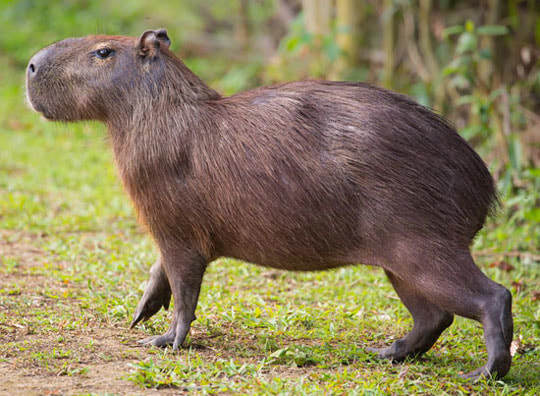
Amazing facts about capybaras
Above, I mentioned that capybaras appear in Bridgers 2, which isn't exactly accurate. It is actually a closely-related creature that lives on another version of Earth. In the Bridgers novels, the characters "bridge" to alternate versions of Earth. They can choose how far back in time their destination world diverged from our own, and so they often encounter creatures that don't exist on our world, although they are similar. In Bridgers 2 , this capybara-like creature is domesticated as a food animal and is raised in large herds. This isn't far-fetched because on our world, capybaras are often hunted for food, and they are known to be gregarious, living in dense groups within small home ranges of about 25 acres (10 hectares). Which means they might do well as livestock.
But... one complication of trying to domesticate capybaras is that they need water. They are semiaquatic mammals. They must always be near bodies of water, such as lakes, rivers, swamps, etc. To be honest, when I look at a capybara, the last thing that comes to mind is that they look like sleek, strong swimmers. But they are! In fact, they can stay completely submerged for five minutes. This is how they escape from predators. They can even sleep in water, keeping just the tip of their nose at the surface. Their eyes, nostrils, and ears are on top of their heads, making it easier for them to stay mostly submerged.
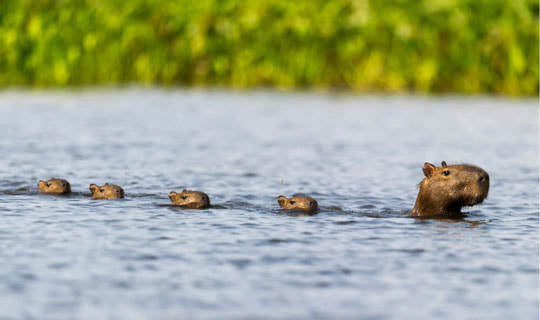
Capybaras are huge rodents. Their average weight is about 100 pounds (45 kg), but the largest ever found was 201 pounds (96 kg). When they were originally discovered, they were called water pigs, although we know now that they are rodents, not pigs. The second largest living rodent is the beaver, with an average weight of about 39 pounds (17 kg). Although the capybara is today's largest rodent, it certainly doesn't hold the record historically. Perhaps the largest prehistoric rodent was the Josephoartigasia, for which a fossilized skull was discovered in Paraguay in 1987. Also a relative of the guinea pig, the Josephoartigasia lived 3 million years ago and is estimated to have weighed 2,200 pounds (1,000 kg). Here's an artist's impression of what this massive rodent looked like:
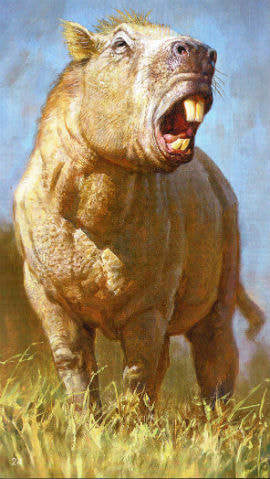
Is it just me, or does that gigantic, one-ton rodent look kind of scary?
Although capybaras are adapted well to the water, they can also run on land. In fact, they can run 22 mph (35 km per hour), as fast as a small horse!
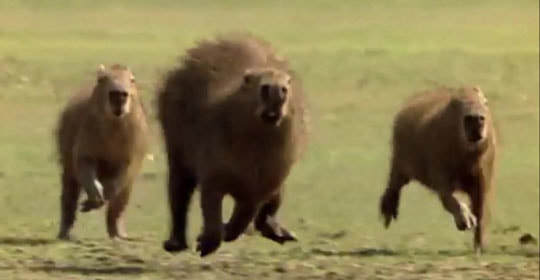
Okay, time for a bit of information on capybara sex and reproduction. These rodents have what's called harem-based polygynous breeding. That's when one male gathers a group of females and then vigorously defends them, preventing other males from getting close. When the male pursues a female, she will typically run into the water. If she is ready to mate, it takes place in the water. Often with the female completely submerged until it is over... good thing it's brief! If the female isn't ready, sometimes she will swim deep enough to dislodge the male (clever, don't you think?).
Both male and female capybaras use scent glands as an important part of their mating routines. Not only do they have anal scent glands, but both sexes also have scent glands on their snouts, called morillos. Especially in the males, the scents produced by the morillo are complex, with up to 54 different compounds. But these 54 compounds are present in different quantities in every male, making the scent subtly different for each individual.
Check out this video of capybaras mating in water.
Capybaras tend to be docile animals. Because of this, they are sometimes kept as pets. I'm not sure this is a good idea, though, because they need a swimming pool or pond to be happy.
Check out this video showing how docile they are.
Not only are they docile to humans, when put into zoo-like surroundings, they tend to be very friendly (or at least tolerant) of other animals around them. Example, squirrel monkeys hitching a ride:
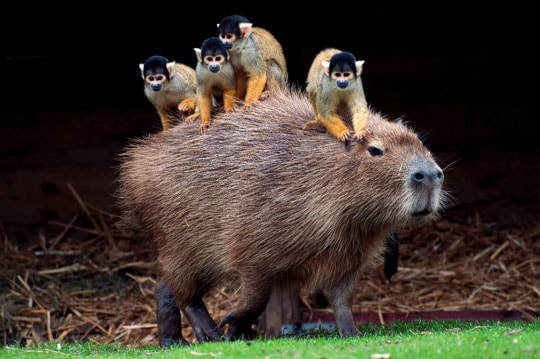
So, the capybara deserves a place in the L.A.H.O.F. (Lit Animal Hall of Fame).
FUN FACT: The word lit has gone through a number of different meanings and is still used for a variety of things. I think originally it meant being high (as in, "John was really lit last night"). It can also mean "being excited" (even sexually excited). But I like its most recent use, to say that something is especially terrific ("This party is lit!"). So it is another way to say awesome.
Photo Credits:
Capybara Walking - Britannica.com
Capybaras swimming - AnimalsLook
Artist's impression of Josephoartigasia - James Gurney
Capybaras running - Capybara World
Capybara and squirrel monkeys - UK Yahoo News
So what the heck is a Capybara ?
The capybara has the honor of being the largest rodent living in the world today. It is in a genus (Hydrochoerus) that includes only two species (along with the lesser capybara). One of its closest relatives is the guinea pig. Capybaras live in South America, with their range covering most of the continent except the west coast. They live in a variety of habitats, from savannahs (a grassland with widely-spaced trees) to dense forests.

Amazing facts about capybaras
Above, I mentioned that capybaras appear in Bridgers 2, which isn't exactly accurate. It is actually a closely-related creature that lives on another version of Earth. In the Bridgers novels, the characters "bridge" to alternate versions of Earth. They can choose how far back in time their destination world diverged from our own, and so they often encounter creatures that don't exist on our world, although they are similar. In Bridgers 2 , this capybara-like creature is domesticated as a food animal and is raised in large herds. This isn't far-fetched because on our world, capybaras are often hunted for food, and they are known to be gregarious, living in dense groups within small home ranges of about 25 acres (10 hectares). Which means they might do well as livestock.
But... one complication of trying to domesticate capybaras is that they need water. They are semiaquatic mammals. They must always be near bodies of water, such as lakes, rivers, swamps, etc. To be honest, when I look at a capybara, the last thing that comes to mind is that they look like sleek, strong swimmers. But they are! In fact, they can stay completely submerged for five minutes. This is how they escape from predators. They can even sleep in water, keeping just the tip of their nose at the surface. Their eyes, nostrils, and ears are on top of their heads, making it easier for them to stay mostly submerged.

Capybaras are huge rodents. Their average weight is about 100 pounds (45 kg), but the largest ever found was 201 pounds (96 kg). When they were originally discovered, they were called water pigs, although we know now that they are rodents, not pigs. The second largest living rodent is the beaver, with an average weight of about 39 pounds (17 kg). Although the capybara is today's largest rodent, it certainly doesn't hold the record historically. Perhaps the largest prehistoric rodent was the Josephoartigasia, for which a fossilized skull was discovered in Paraguay in 1987. Also a relative of the guinea pig, the Josephoartigasia lived 3 million years ago and is estimated to have weighed 2,200 pounds (1,000 kg). Here's an artist's impression of what this massive rodent looked like:

Is it just me, or does that gigantic, one-ton rodent look kind of scary?
Although capybaras are adapted well to the water, they can also run on land. In fact, they can run 22 mph (35 km per hour), as fast as a small horse!

Okay, time for a bit of information on capybara sex and reproduction. These rodents have what's called harem-based polygynous breeding. That's when one male gathers a group of females and then vigorously defends them, preventing other males from getting close. When the male pursues a female, she will typically run into the water. If she is ready to mate, it takes place in the water. Often with the female completely submerged until it is over... good thing it's brief! If the female isn't ready, sometimes she will swim deep enough to dislodge the male (clever, don't you think?).
Both male and female capybaras use scent glands as an important part of their mating routines. Not only do they have anal scent glands, but both sexes also have scent glands on their snouts, called morillos. Especially in the males, the scents produced by the morillo are complex, with up to 54 different compounds. But these 54 compounds are present in different quantities in every male, making the scent subtly different for each individual.
Check out this video of capybaras mating in water.
Capybaras tend to be docile animals. Because of this, they are sometimes kept as pets. I'm not sure this is a good idea, though, because they need a swimming pool or pond to be happy.
Check out this video showing how docile they are.
Not only are they docile to humans, when put into zoo-like surroundings, they tend to be very friendly (or at least tolerant) of other animals around them. Example, squirrel monkeys hitching a ride:

So, the capybara deserves a place in the L.A.H.O.F. (Lit Animal Hall of Fame).
FUN FACT: The word lit has gone through a number of different meanings and is still used for a variety of things. I think originally it meant being high (as in, "John was really lit last night"). It can also mean "being excited" (even sexually excited). But I like its most recent use, to say that something is especially terrific ("This party is lit!"). So it is another way to say awesome.
Photo Credits:
Capybara Walking - Britannica.com
Capybaras swimming - AnimalsLook
Artist's impression of Josephoartigasia - James Gurney
Capybaras running - Capybara World
Capybara and squirrel monkeys - UK Yahoo News
Published on February 09, 2018 05:28
January 24, 2018
Awesome Animal - Spring Peeper
For those not familiar with January in Missouri (central US), I'll describe it. January is perhaps the coldest month of the year here. The trees are bare and the ground vegetation is brown and dead. There are no insects around, so those animals that eat insects (at least those that live above ground) must hibernate or migrate. Most of the nights are below freezing, and it can get to -10 F (-23 C).
But that doesn't mean we don't have the odd warm day. Trish and I just got back from several relaxing days at our rustic little cabin in the Missouri Ozarks. On Sunday, the temperature hit 71 F (22 C). This happens occasionally. But amazingly, in the afternoon the woods behind our cabin suddenly filled with the beautiful calls of the tiny frog called the spring peeper !
Some of you in warmer areas may hear frogs all year around, but hearing them here in January is a real treat. So to celebrate this event, I have chosen the spring peeper as the Awesome Animal for this post.
Here's what the forest behind our cabin typically looks like in January. This was January 19th, from a trail camera we've installed to get photos of wildlife (this lovely picture of the snowy forest was photo-bombed by a white-tailed deer).
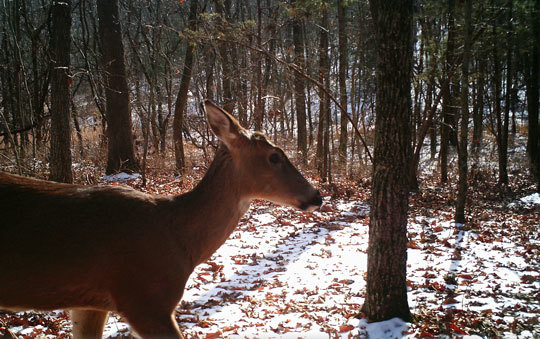
Often I feature animals that show up in my novels, but not this time. This email is in honor of those brave little frogs that dared to awaken and begin calling on January 21st in the Missouri woodlands.
So what the heck is a Spring Peeper ?
Spring peepers are frogs, so they are in the class Amphibia (amphibians). Their scientific name is Pseudacris crucifer. The second part of the name comes from the fact that they have a distinct X (cross) on their back. They live in the eastern half of North America, including eastern Canada.
Spring peepers are only about one inch long, but their call is extremely loud for such a tiny critter. They are usually the first frog to become active and start calling in early spring, so their call is a welcome sound to many people.
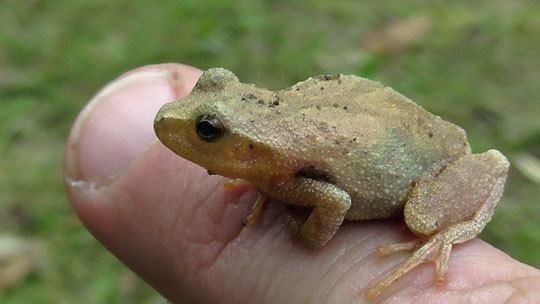
Amazing facts about Spring Peepers
So, why would Trish and I hear spring peepers in mid-January? To understand this, it is important to know how frogs spend their winters. Amphibians have porous skin, and oxygen can pass through it. When winter approaches, frogs simply swim to the bottom of a pond and wriggle back and forth until they are partially or completely under the mud (some of them crawl into the mud beneath rotting logs). When the temperature drops, their metabolism slows down enough that their skin can absorb adequate oxygen from the surrounding water. If the temperature gets too warm, their metabolism increases and their skin cannot take in enough oxygen to sustain them, so they have to swim to the surface to breathe with their lungs.
So on January 21st, when the temperature rose to 71 F, the ice thawed out and the water warmed up enough that the spring peepers were forced to emerge to the surface. And if you're a male spring peeper, when you get to the surface, you have this uncontrollable urge to call for a mate. And that's why Trish and I were treated to a symphony of horny frogs in the middle of winter!
Check out this video of spring peepers calling.
If these frogs choose to spend their winter at the bottom of a rather shallow pond, that pond may freeze completely. Well, not to worry. Spring peepers are one of only five frogs in North America that can survive being frozen. When the temperature of the water or mud around them drops below freezing, their body starts producing a natural antifreeze, which protects their most vital organs. But 70% of their body freezes solid! Their heart even stops beating, and they appear to be dead. We still don't completely understand how these frozen frogs are able to come back to life. They are tough little frogs!

Spring peepers have an impressive vocal sac.The vocal sac is that bulging throat you see under the chin of many male frogs. It's a flexible membrane that amplifies the sound of the male frog's call. The vocal sac, in fact, is one reliable way to tell the difference between males and females of many frog species. There are two slits in the bottom of the male's mouth connecting the mouth to the vocal sac. The frog fills its lungs with air, closes its nose and mouth, and blows the air through its vocal chord (larynx), producing its call. The louder the call, the better, because the nearest female may be way over in the next pond.
Although spring peepers are a type of chorus frog, they have something in common with tree frogs: sticky toe pads that allow them to cling to leaves and other surfaces. They can climb vertical surfaces and even cling to leaves upside down. A study in 2009 revealed how frog toe pads work. If you look very closely, the toe pad surface is covered with flat-topped cells surrounded by grooves filled with mucus. But when scientists looked even closer at those flat-topped cells with a special super-duper microscope (called an atomic force microscope), they saw that they were covered with jillions of tiny "nanopillars." With all these nanopillars, a huge amount of surface area comes in contact with the climbing surface, and the mucus helps to provide adhesive forces. It's an amazing adaptation.

Like many other frogs, spring peepers take the shotgun approach to breeding. Since most of their young are eaten by other predators in the water, they lay about 900 eggs! This makes it more likely a few of them will survive. In the spring, when a male successfully calls a female to him, he will climb onto her back and hold on tight (this is called amplexus) until she lays her eggs (eggs are layed in the water). Amplexus puts the male in a good position to release sperm onto the eggs as they come out of the female's body. By the way, this amplexus is such a powerful instinct in male frogs that I have seen triple-decker amplexus before (where a second male clings to the back of a male that is clinging to the back of a female, perhaps in hopes of getting his sperm onto some of the eggs). As you can imagine, since spring peepers are small, and they lay 900 eggs, the resulting tadpoles are really small:
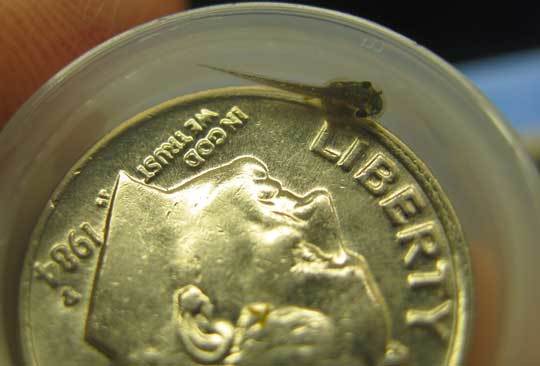
So, the spring peeper deserves a place in the O.F.A.H.O.F. (On-Fleek Animal Hall of Fame).
FUN FACT: On fleek is a relatively new term (used by people much younger than me). It's an adjective to describe something that is so good that it's "on point." It originated as a reference to eyebrows (eyebrows waxed to perfection are "on fleek"), but now can be used to describe just about anything that is outstanding. So it is another way to say awesome.
Photo Credits:
Spring Peeper on finger - Little Peppers Field Guide
Spring Peeper Vocal Sac - Farmer's Almanac
Spring Peeper Toe Pads - Hilton Pond Center
Spring Peeper in Snow - Naturally Curious with Mary Holland
Spring Peeper Tadpole - Capital Naturalist
But that doesn't mean we don't have the odd warm day. Trish and I just got back from several relaxing days at our rustic little cabin in the Missouri Ozarks. On Sunday, the temperature hit 71 F (22 C). This happens occasionally. But amazingly, in the afternoon the woods behind our cabin suddenly filled with the beautiful calls of the tiny frog called the spring peeper !
Some of you in warmer areas may hear frogs all year around, but hearing them here in January is a real treat. So to celebrate this event, I have chosen the spring peeper as the Awesome Animal for this post.
Here's what the forest behind our cabin typically looks like in January. This was January 19th, from a trail camera we've installed to get photos of wildlife (this lovely picture of the snowy forest was photo-bombed by a white-tailed deer).

Often I feature animals that show up in my novels, but not this time. This email is in honor of those brave little frogs that dared to awaken and begin calling on January 21st in the Missouri woodlands.
So what the heck is a Spring Peeper ?
Spring peepers are frogs, so they are in the class Amphibia (amphibians). Their scientific name is Pseudacris crucifer. The second part of the name comes from the fact that they have a distinct X (cross) on their back. They live in the eastern half of North America, including eastern Canada.
Spring peepers are only about one inch long, but their call is extremely loud for such a tiny critter. They are usually the first frog to become active and start calling in early spring, so their call is a welcome sound to many people.

Amazing facts about Spring Peepers
So, why would Trish and I hear spring peepers in mid-January? To understand this, it is important to know how frogs spend their winters. Amphibians have porous skin, and oxygen can pass through it. When winter approaches, frogs simply swim to the bottom of a pond and wriggle back and forth until they are partially or completely under the mud (some of them crawl into the mud beneath rotting logs). When the temperature drops, their metabolism slows down enough that their skin can absorb adequate oxygen from the surrounding water. If the temperature gets too warm, their metabolism increases and their skin cannot take in enough oxygen to sustain them, so they have to swim to the surface to breathe with their lungs.
So on January 21st, when the temperature rose to 71 F, the ice thawed out and the water warmed up enough that the spring peepers were forced to emerge to the surface. And if you're a male spring peeper, when you get to the surface, you have this uncontrollable urge to call for a mate. And that's why Trish and I were treated to a symphony of horny frogs in the middle of winter!
Check out this video of spring peepers calling.
If these frogs choose to spend their winter at the bottom of a rather shallow pond, that pond may freeze completely. Well, not to worry. Spring peepers are one of only five frogs in North America that can survive being frozen. When the temperature of the water or mud around them drops below freezing, their body starts producing a natural antifreeze, which protects their most vital organs. But 70% of their body freezes solid! Their heart even stops beating, and they appear to be dead. We still don't completely understand how these frozen frogs are able to come back to life. They are tough little frogs!

Spring peepers have an impressive vocal sac.The vocal sac is that bulging throat you see under the chin of many male frogs. It's a flexible membrane that amplifies the sound of the male frog's call. The vocal sac, in fact, is one reliable way to tell the difference between males and females of many frog species. There are two slits in the bottom of the male's mouth connecting the mouth to the vocal sac. The frog fills its lungs with air, closes its nose and mouth, and blows the air through its vocal chord (larynx), producing its call. The louder the call, the better, because the nearest female may be way over in the next pond.

Although spring peepers are a type of chorus frog, they have something in common with tree frogs: sticky toe pads that allow them to cling to leaves and other surfaces. They can climb vertical surfaces and even cling to leaves upside down. A study in 2009 revealed how frog toe pads work. If you look very closely, the toe pad surface is covered with flat-topped cells surrounded by grooves filled with mucus. But when scientists looked even closer at those flat-topped cells with a special super-duper microscope (called an atomic force microscope), they saw that they were covered with jillions of tiny "nanopillars." With all these nanopillars, a huge amount of surface area comes in contact with the climbing surface, and the mucus helps to provide adhesive forces. It's an amazing adaptation.

Like many other frogs, spring peepers take the shotgun approach to breeding. Since most of their young are eaten by other predators in the water, they lay about 900 eggs! This makes it more likely a few of them will survive. In the spring, when a male successfully calls a female to him, he will climb onto her back and hold on tight (this is called amplexus) until she lays her eggs (eggs are layed in the water). Amplexus puts the male in a good position to release sperm onto the eggs as they come out of the female's body. By the way, this amplexus is such a powerful instinct in male frogs that I have seen triple-decker amplexus before (where a second male clings to the back of a male that is clinging to the back of a female, perhaps in hopes of getting his sperm onto some of the eggs). As you can imagine, since spring peepers are small, and they lay 900 eggs, the resulting tadpoles are really small:

So, the spring peeper deserves a place in the O.F.A.H.O.F. (On-Fleek Animal Hall of Fame).
FUN FACT: On fleek is a relatively new term (used by people much younger than me). It's an adjective to describe something that is so good that it's "on point." It originated as a reference to eyebrows (eyebrows waxed to perfection are "on fleek"), but now can be used to describe just about anything that is outstanding. So it is another way to say awesome.
Photo Credits:
Spring Peeper on finger - Little Peppers Field Guide
Spring Peeper Vocal Sac - Farmer's Almanac
Spring Peeper Toe Pads - Hilton Pond Center
Spring Peeper in Snow - Naturally Curious with Mary Holland
Spring Peeper Tadpole - Capital Naturalist
Published on January 24, 2018 09:40
January 11, 2018
Awesome Animal - Orb-Weaving Spider
I enjoy featuring animals that show up in my novels. In Diffusion, there is a scene where Samual shows Quentin one of the huge orb-weaving spiders that produce the silk the Papuan natives use to make incredibly strong rope. As it turns out, the spider in my story is not as exaggerated as you might think. Today's awesome animal is the orb-weaving spider, especially the giant golden orb-weaver.
So what the heck is an Orb-Weaving Spider ?
Orb-weavers are a large family of spiders that include over 3,100 species. These are the spiders that typically build large, spiral webs in your garden. Their webs are typically wheel-shaped, and that's how they got the name of orb-weavers (orb general means circular).
I am going to focus mainly on the golden orb-weavers (spiders of the genus Nephila). Why? Because they are some of the largest and most beautiful spiders. Below is a photo of a golden orb weaver Trish and I encountered on a hike in Costa Rica:

Amazing facts about Orb-Weaving Spiders
Some orb-weavers are quite large. The females of the giant golden orb-weaver can have a body length of up to 3 inches (75 mm), and with the long legs included, a entire length of 6 inches (150 mm).
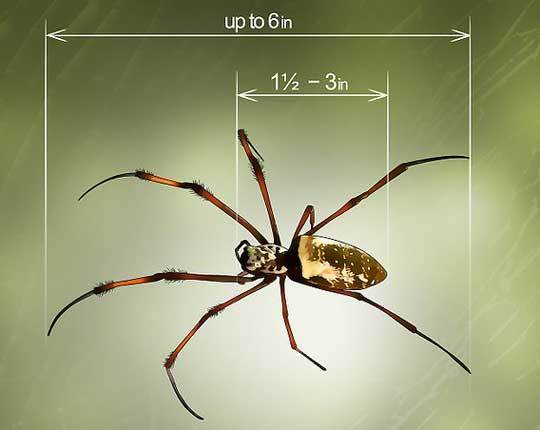
But the most striking thing about their size is that the females are HUGE compared to the males. When the male and female of a species are different from each other, it is called sexual dimorphism. But orb-weaving spiders have taken the concept of sexual dimorphism to the extreme. The females can be up to TEN times longer than the males. And this means the male weighs less than 5% of the weight of the female. Wow! Just for kicks, let's convert that to human terms. Let's say there is a 140-pound woman. Her mate would be a man who weighs less than SEVEN pounds. Okay, that's just a little weird to think about.
Check out this video of a male and a female golden orb-weaver.
There are two main theories for why they are so different in size:
Theory #1 : In many spiders, once the male mates with the female, he inserts a "mating plug" in the female, which prevents other males from mating with her (I am not making this up!). By doing this, the male can be sure he is the father of all the offspring of that female. But in giant orb-weavers, these plugs do not seem to work. And so the theory is that the females of these species have evolved to be very large so that they can be too large for the plugs to work, thus ensuring that they can produce young from more than one male (more diverse offspring, which is a good thing from the female's perpective).
Theory #2: In giant orb-weavers, the males that find and mate with a specific female first will fertilize more of her eggs than males that find her later. And smaller males are faster, so they can scramble around through the vegetation and find females faster than larger males. And thus the males have evolved to have a smaller size.
Again, I'm not making this stuff up. See the male and female in the photo below.
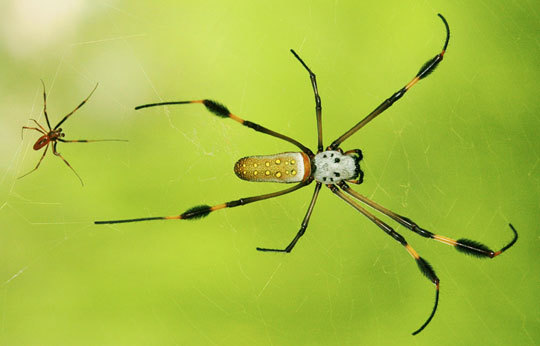
Well, as you can imagine, for a tiny male orb-weaver, mating with a giant female is risky business. The females have a habit of eating the males after the "job" is complete. But some male orb-weavers have a special strategy to avoid this. It's called mate-binding. To make the females more receptive (and less likely to cannibalize them), the males spread silk over the female's back, in a motion that looks very much like he is giving her a massage. Research shows that this massaging motion makes the female relax, and therefore she is less likely to eat the male. Here is a video of mate binding in orb weavers.
Although most orb-weavers are fairly docile, they can certainly bite. But they are not dangerous to humans. They inject neurotoxin, like a black widow spider, but it is much less toxic.
As I mentioned earlier, in my Diffusion novels orb-weaver silk is used to make very strong rope. This is actually possible, assuming there is a good way to harvest lots of spider silk, because orb-weaver silk is strong! In fact, it's the strongest biological material we know of. It is more than ten times stronger than a strand of Kevlar of the same diameter. The recently-discovered Darwin's Bark Spider, a type of orb-weaver, has the strongest silk of any spider. They create webs that are more than 80 feet (25 meters) wide! The actual circular part of the web (the part that catches insects and other small animals) can be a meter in diameter. See the Darwin's bark spider web below.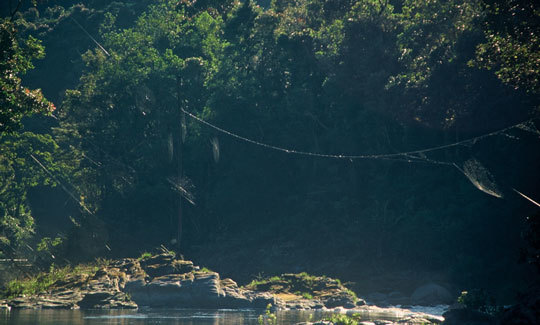
In Diffusion, Samuel Inwood made his vest from orb-weaver silk. Actually, few people have been able to do this, as spider silk is not easy to collect in large amounts. In 2012, a textile designer and an entrepreneur collected golden orb-weavers from the wild and managed to get enough silk to create a beautiful cape, which was put on display at the Victoria and Albert Museum in London (see photo below). It took over three years to make!
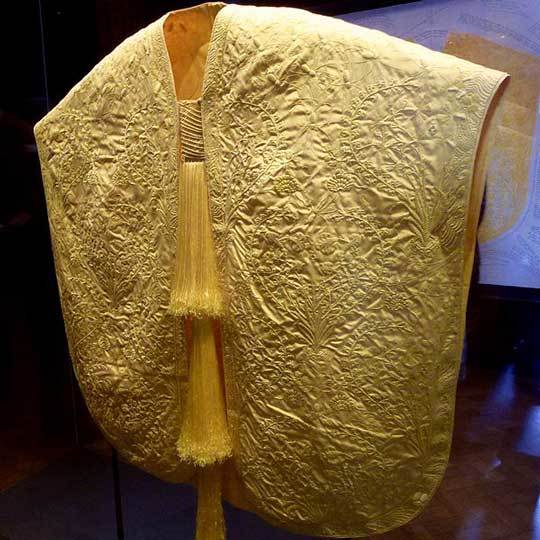
So, the orb-weaving spider deserves a place in the H.S.A.H.O.F. (Heart-Stopping Animal Hall of Fame).
FUN FACT: The first-known use of the phrase heart-stopping was in 1888. It is possible that it started as a reference to the (incorrect) assumption people used to have that one's heart would stop when sneezing. Today it refers to anything that is so frightening or emotionally gripping as to make one's heart seem to stop beating. I like to use it in a positive way, though, to describe something amazing or exciting. So it is another way to say awesome.
Photo Credits:
Golden Orb-Weaver on fingers - Stan C. Smith
Golden Orb-Weaver Size Diagram - WikiHow
Male and Female Orb-Weavers - National Geographic
Darwin's Bark Spider Web - Wikimedia Commons
Orb-weaver Silk Cape - Wikimedia Commons
So what the heck is an Orb-Weaving Spider ?
Orb-weavers are a large family of spiders that include over 3,100 species. These are the spiders that typically build large, spiral webs in your garden. Their webs are typically wheel-shaped, and that's how they got the name of orb-weavers (orb general means circular).
I am going to focus mainly on the golden orb-weavers (spiders of the genus Nephila). Why? Because they are some of the largest and most beautiful spiders. Below is a photo of a golden orb weaver Trish and I encountered on a hike in Costa Rica:

Amazing facts about Orb-Weaving Spiders
Some orb-weavers are quite large. The females of the giant golden orb-weaver can have a body length of up to 3 inches (75 mm), and with the long legs included, a entire length of 6 inches (150 mm).

But the most striking thing about their size is that the females are HUGE compared to the males. When the male and female of a species are different from each other, it is called sexual dimorphism. But orb-weaving spiders have taken the concept of sexual dimorphism to the extreme. The females can be up to TEN times longer than the males. And this means the male weighs less than 5% of the weight of the female. Wow! Just for kicks, let's convert that to human terms. Let's say there is a 140-pound woman. Her mate would be a man who weighs less than SEVEN pounds. Okay, that's just a little weird to think about.
Check out this video of a male and a female golden orb-weaver.
There are two main theories for why they are so different in size:
Theory #1 : In many spiders, once the male mates with the female, he inserts a "mating plug" in the female, which prevents other males from mating with her (I am not making this up!). By doing this, the male can be sure he is the father of all the offspring of that female. But in giant orb-weavers, these plugs do not seem to work. And so the theory is that the females of these species have evolved to be very large so that they can be too large for the plugs to work, thus ensuring that they can produce young from more than one male (more diverse offspring, which is a good thing from the female's perpective).
Theory #2: In giant orb-weavers, the males that find and mate with a specific female first will fertilize more of her eggs than males that find her later. And smaller males are faster, so they can scramble around through the vegetation and find females faster than larger males. And thus the males have evolved to have a smaller size.
Again, I'm not making this stuff up. See the male and female in the photo below.

Well, as you can imagine, for a tiny male orb-weaver, mating with a giant female is risky business. The females have a habit of eating the males after the "job" is complete. But some male orb-weavers have a special strategy to avoid this. It's called mate-binding. To make the females more receptive (and less likely to cannibalize them), the males spread silk over the female's back, in a motion that looks very much like he is giving her a massage. Research shows that this massaging motion makes the female relax, and therefore she is less likely to eat the male. Here is a video of mate binding in orb weavers.
Although most orb-weavers are fairly docile, they can certainly bite. But they are not dangerous to humans. They inject neurotoxin, like a black widow spider, but it is much less toxic.
As I mentioned earlier, in my Diffusion novels orb-weaver silk is used to make very strong rope. This is actually possible, assuming there is a good way to harvest lots of spider silk, because orb-weaver silk is strong! In fact, it's the strongest biological material we know of. It is more than ten times stronger than a strand of Kevlar of the same diameter. The recently-discovered Darwin's Bark Spider, a type of orb-weaver, has the strongest silk of any spider. They create webs that are more than 80 feet (25 meters) wide! The actual circular part of the web (the part that catches insects and other small animals) can be a meter in diameter. See the Darwin's bark spider web below.

In Diffusion, Samuel Inwood made his vest from orb-weaver silk. Actually, few people have been able to do this, as spider silk is not easy to collect in large amounts. In 2012, a textile designer and an entrepreneur collected golden orb-weavers from the wild and managed to get enough silk to create a beautiful cape, which was put on display at the Victoria and Albert Museum in London (see photo below). It took over three years to make!

So, the orb-weaving spider deserves a place in the H.S.A.H.O.F. (Heart-Stopping Animal Hall of Fame).
FUN FACT: The first-known use of the phrase heart-stopping was in 1888. It is possible that it started as a reference to the (incorrect) assumption people used to have that one's heart would stop when sneezing. Today it refers to anything that is so frightening or emotionally gripping as to make one's heart seem to stop beating. I like to use it in a positive way, though, to describe something amazing or exciting. So it is another way to say awesome.
Photo Credits:
Golden Orb-Weaver on fingers - Stan C. Smith
Golden Orb-Weaver Size Diagram - WikiHow
Male and Female Orb-Weavers - National Geographic
Darwin's Bark Spider Web - Wikimedia Commons
Orb-weaver Silk Cape - Wikimedia Commons
Published on January 11, 2018 17:18
December 29, 2017
Awesome Animal - Cuscus
I enjoy featuring animals that show up in my novels. Today's Awesome Animal appears in
Infusion
. Haven't read
Infusion
yet? Hmm... you know, there's a painless and reliable cure for that unfortunate condition. Anyway, there is a scene where Bobby asks the Lamotelokokhai to prove to him that it has detailed knowledge of every living creature it has ever encountered in the past. The result of this request is rather shocking. I'll just say it involves creating a Cuscus, an unusual and extremely adorable creature.
So what the heck is a Cuscus ?
Pronounced "cuss-cuss." Like many of the mammals of Australia, New Guinea, and the surrounding islands, cuscuses are marsupials (their young develop outside the mother's body in a pouch). Generally, they are considered possums, and there are four genera and about 23 species (although since they live high in the canopy of remote tropical forests, it wouldn't surprise me if a few more species were eventually discovered).
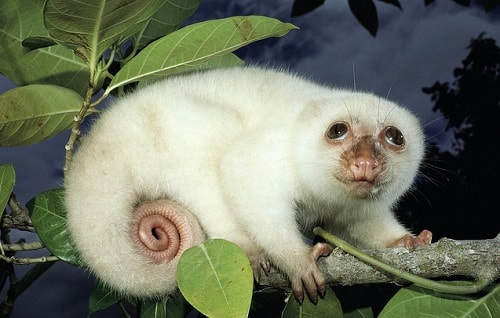
Okay, before I go on to the amazing facts, just take a moment to look at the photo above. The naked prehensile tail might make a few people say "Ewww." But look beyond that and check out that face! I think I need to nominate the cuscus as the animal most likely to be mistaken for a cartoon character.
Amazing facts about Cuscuses
I mentioned above that it is possible new cuscus species could be found. This is because they live in some of the most inaccessible forests in the world. In fact, a new species was discovered in 2009, in the forest that covers an inactive volcano in Papua New Guinea called Mount Bosavi. It was named the Bosavi Silky Cuscus. See image below. And check out this video of the discovery of the Silky Cuscus in 2009.

Most cuscuses are about the size of a housecat (body length about 18 inches with a tail about the same length). They have round heads with small ears that are usually hidden by fur, which makes that tennis ball-like head seem even more spherical. But one of the most amazing things about their appearance is their colors. They can be black, brown, gray, and sometimes lighter colors such as tan, white, or cream. In fact, they can even be a mix of these colors, with a spotted or mottled appearance. Because of this, they are perhaps the most colorful of all marsupials. The females and males often have different colors, allowing us to distinguish between genders. And their colors often change as they mature. Check out the spotted cuscus featured on this Papua New Guinea stamp:
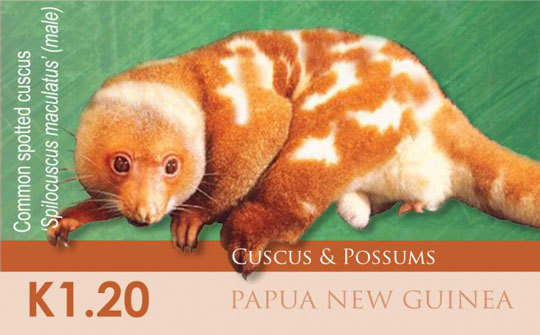
Cuscuses spend almost their entire lives in trees. To help them climb, they have some interesting adaptations. For example, they have prehensile tails that look almost like very long fingers. These tails can grip so hard that it is difficult for a person to loosen them if the cuscus is determined to hold on. They also have opposable digits, like a human's opposable thumb, only cuscuses also have opposable toes.
The biggest danger to cuscuses is the loss of tropical forest habitat. And their main predator of is humans. They are widely hunted for food and their fur, especially in New Guinea. Other than humans, they are sometimes eaten by pythons and birds of prey.
Cuscuses usually sleep on branches in the open, with their heads tucked between their legs. To help with camouflage, they sometimes pull leaves and branches over their bodies. However, there are some species (like the Ground Cuscus, pictured below) that live in burrows and move to the trees at night to feed.
Cuscuses are marsupials, so they give birth to young after a very short gestation period, typically only a couple weeks. But then the babies crawl to the mother's pouch, where they continue to develop for six to seven months. Oddly enough, although two to four are usually born, only ONE will survive and emerge from the pouch to live on its own.
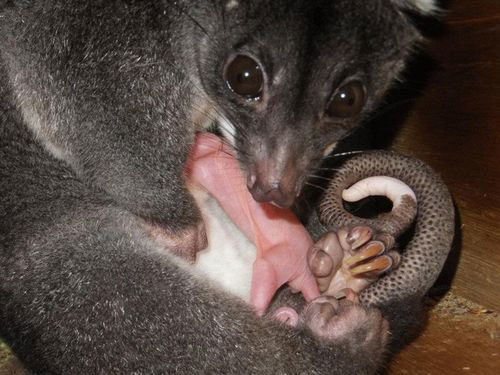
Okay, I think I've decided what it is about the appearance of these creatures that intrigues me so much. It's their eyes! Obviously, cuscus eyes are adapted for seeing at night. But the way they are arranged on the face for looking forward and the bulging roundness of them gives these creatures an appearance unlike any other mammal. Below is the Sulawesi Bear Cuscus.
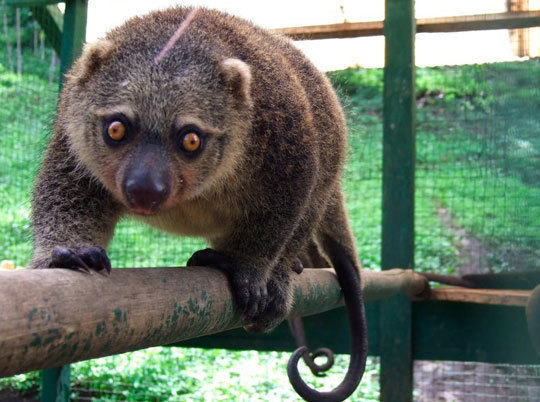
So, the cuscus deserves a place in the M.B.A.H.O.F. (Mind-Blowing Animal Hall of Fame).
FUN FACT: The term mind-blowing originated in the 1960s drug counterculture. Its original meaning was producing hallucinatory effects. But it has gradually evolved to have a more general meaning: something that is so shocking, surprising, unexpected or wonderful that your brain cannot comprehend it. So it is another way to say awesome.
Photo Credits:
Spotted Cuscus (white) - Wildlife Planet
Bosavi Silky Cuscus - National Geographic
Spotted Cuscus on PNG stamp - Post PNG
Baby Ground Cuscus - ZooBorns
Sulawesi Bear Cuscus - Indonesia Travel
So what the heck is a Cuscus ?
Pronounced "cuss-cuss." Like many of the mammals of Australia, New Guinea, and the surrounding islands, cuscuses are marsupials (their young develop outside the mother's body in a pouch). Generally, they are considered possums, and there are four genera and about 23 species (although since they live high in the canopy of remote tropical forests, it wouldn't surprise me if a few more species were eventually discovered).

Okay, before I go on to the amazing facts, just take a moment to look at the photo above. The naked prehensile tail might make a few people say "Ewww." But look beyond that and check out that face! I think I need to nominate the cuscus as the animal most likely to be mistaken for a cartoon character.
Amazing facts about Cuscuses
I mentioned above that it is possible new cuscus species could be found. This is because they live in some of the most inaccessible forests in the world. In fact, a new species was discovered in 2009, in the forest that covers an inactive volcano in Papua New Guinea called Mount Bosavi. It was named the Bosavi Silky Cuscus. See image below. And check out this video of the discovery of the Silky Cuscus in 2009.

Most cuscuses are about the size of a housecat (body length about 18 inches with a tail about the same length). They have round heads with small ears that are usually hidden by fur, which makes that tennis ball-like head seem even more spherical. But one of the most amazing things about their appearance is their colors. They can be black, brown, gray, and sometimes lighter colors such as tan, white, or cream. In fact, they can even be a mix of these colors, with a spotted or mottled appearance. Because of this, they are perhaps the most colorful of all marsupials. The females and males often have different colors, allowing us to distinguish between genders. And their colors often change as they mature. Check out the spotted cuscus featured on this Papua New Guinea stamp:

Cuscuses spend almost their entire lives in trees. To help them climb, they have some interesting adaptations. For example, they have prehensile tails that look almost like very long fingers. These tails can grip so hard that it is difficult for a person to loosen them if the cuscus is determined to hold on. They also have opposable digits, like a human's opposable thumb, only cuscuses also have opposable toes.
The biggest danger to cuscuses is the loss of tropical forest habitat. And their main predator of is humans. They are widely hunted for food and their fur, especially in New Guinea. Other than humans, they are sometimes eaten by pythons and birds of prey.
Cuscuses usually sleep on branches in the open, with their heads tucked between their legs. To help with camouflage, they sometimes pull leaves and branches over their bodies. However, there are some species (like the Ground Cuscus, pictured below) that live in burrows and move to the trees at night to feed.
Cuscuses are marsupials, so they give birth to young after a very short gestation period, typically only a couple weeks. But then the babies crawl to the mother's pouch, where they continue to develop for six to seven months. Oddly enough, although two to four are usually born, only ONE will survive and emerge from the pouch to live on its own.

Okay, I think I've decided what it is about the appearance of these creatures that intrigues me so much. It's their eyes! Obviously, cuscus eyes are adapted for seeing at night. But the way they are arranged on the face for looking forward and the bulging roundness of them gives these creatures an appearance unlike any other mammal. Below is the Sulawesi Bear Cuscus.

So, the cuscus deserves a place in the M.B.A.H.O.F. (Mind-Blowing Animal Hall of Fame).
FUN FACT: The term mind-blowing originated in the 1960s drug counterculture. Its original meaning was producing hallucinatory effects. But it has gradually evolved to have a more general meaning: something that is so shocking, surprising, unexpected or wonderful that your brain cannot comprehend it. So it is another way to say awesome.
Photo Credits:
Spotted Cuscus (white) - Wildlife Planet
Bosavi Silky Cuscus - National Geographic
Spotted Cuscus on PNG stamp - Post PNG
Baby Ground Cuscus - ZooBorns
Sulawesi Bear Cuscus - Indonesia Travel
Published on December 29, 2017 06:54
December 13, 2017
Something to Consider
Recently I've tossed out some hints regarding my next book,
Bridgers
. Here's a bit more.
Let's say the remarkable concept of infinite parallel universes has been proven to be true, and humans have constructed a device that can send you to another version of Earth for 36 hours. One of the interesting aspects of this device, though, is that you can "dial back" to any point of divergence you want.
Warning - Crazy Explanation: Infinite universes really does mean INFINITE. There is another universe for every possible combination of atoms. So there are universes nearly identical to ours and those that are vastly different.
The device mentioned above allows you to choose how far back your destination world diverged from our own. Let's say you choose to visit a world that diverged from ours ten minutes ago. This means the world was identical to ours in every way up until ten minutes ago. But for the last ten minutes, events on that world have been independent of our world. Not much can happen in ten minutes, so that world would be very similar to ours, including all the people (except for those who died in that ten minutes on one world but not on the other).
If you choose a world that diverged ten years ago, it would still be similar. But a lot can happen in ten years. Elections could have resulted in different leaders, for example, resulting in somewhat different social landscapes.
What about a world that diverged 100 years ago? None of the same people would exist, except those who are more than 100 years old.
What about 1,000 years ago? That world could look quite different, right? Different languages, different political boundaries. Maybe even the extinction of life on Earth due to imprudent use of nuclear weapons.
What about a world that diverged 10,000 years ago? Or 100,000? or 100 million?
Boggles the mind, doesn't it?
 Keep in mind this isn't time travel. If you leave this world on December 12, it will be December 12 on the alternate version of Earth you visit. But you get to choose how far back the world
diverged
from ours.
Keep in mind this isn't time travel. If you leave this world on December 12, it will be December 12 on the alternate version of Earth you visit. But you get to choose how far back the world
diverged
from ours.
So here is a question for you:
If you had the opportunity to visit an alternate version of Earth, how far back would you want the divergence point?
I would love to hear your opinion on this.
I invite you to Comment to this post and give me your thoughts.
I am almost done writing my new book, Bridgers !

Let's say the remarkable concept of infinite parallel universes has been proven to be true, and humans have constructed a device that can send you to another version of Earth for 36 hours. One of the interesting aspects of this device, though, is that you can "dial back" to any point of divergence you want.
Warning - Crazy Explanation: Infinite universes really does mean INFINITE. There is another universe for every possible combination of atoms. So there are universes nearly identical to ours and those that are vastly different.
The device mentioned above allows you to choose how far back your destination world diverged from our own. Let's say you choose to visit a world that diverged from ours ten minutes ago. This means the world was identical to ours in every way up until ten minutes ago. But for the last ten minutes, events on that world have been independent of our world. Not much can happen in ten minutes, so that world would be very similar to ours, including all the people (except for those who died in that ten minutes on one world but not on the other).
If you choose a world that diverged ten years ago, it would still be similar. But a lot can happen in ten years. Elections could have resulted in different leaders, for example, resulting in somewhat different social landscapes.
What about a world that diverged 100 years ago? None of the same people would exist, except those who are more than 100 years old.
What about 1,000 years ago? That world could look quite different, right? Different languages, different political boundaries. Maybe even the extinction of life on Earth due to imprudent use of nuclear weapons.
What about a world that diverged 10,000 years ago? Or 100,000? or 100 million?
Boggles the mind, doesn't it?
 Keep in mind this isn't time travel. If you leave this world on December 12, it will be December 12 on the alternate version of Earth you visit. But you get to choose how far back the world
diverged
from ours.
Keep in mind this isn't time travel. If you leave this world on December 12, it will be December 12 on the alternate version of Earth you visit. But you get to choose how far back the world
diverged
from ours.So here is a question for you:
If you had the opportunity to visit an alternate version of Earth, how far back would you want the divergence point?
I would love to hear your opinion on this.
I invite you to Comment to this post and give me your thoughts.
I am almost done writing my new book, Bridgers !

Published on December 13, 2017 06:00
Infinite Parallel Universes and my New Series
Did you know the concept of infinite parallel universes is more than just fodder for science fiction stories? The concept has actually long been considered by physicists to be a real possibility.
It is important to point out that multiple universes is not a theory. Scientists did not suddenly come up with the idea using their imaginations. Instead, the concept is a mathematical consequence of our current theories in physics, particularly quantum mechanics and string theory. What this means, essentially, is that even those physicists who are skeptical of the idea must examine it as a real possibility (even if they do so reluctantly).
I have an academic background in biology. Fortunately for me, my father and one of my brothers are physicists, and sometimes I can run my wild ideas by them for feedback.
For my new upcoming series, I have placed the infinite universes concept into a framework of adrenaline-fueled wilderness survival. If you have enjoyed the fantastic creatures, danger, narrow escapes, and interesting characters of my Diffusion series, you are going to love my new books.
I'm going to reveal the title of the first book: Bridgers
 What are bridgers, you ask? They are people hired to protect "tourists" paying large sums of money to bridge to an alternate version of Earth. Bridgers have specialized skills. They are experts at wilderness survival, making primitive weapons from available materials, and most of all, hand-to-hand fighting.
What are bridgers, you ask? They are people hired to protect "tourists" paying large sums of money to bridge to an alternate version of Earth. Bridgers have specialized skills. They are experts at wilderness survival, making primitive weapons from available materials, and most of all, hand-to-hand fighting.
Why? Because bridging to an alternate world strips away all nonliving matter from your body.
Thirty-six hours. No weapons, no clothing, no knowledge of your destination environment.
It's the ultimate adventure excursion.
I'll share more details soon. I'm hyper-excited about it!
It is important to point out that multiple universes is not a theory. Scientists did not suddenly come up with the idea using their imaginations. Instead, the concept is a mathematical consequence of our current theories in physics, particularly quantum mechanics and string theory. What this means, essentially, is that even those physicists who are skeptical of the idea must examine it as a real possibility (even if they do so reluctantly).
I have an academic background in biology. Fortunately for me, my father and one of my brothers are physicists, and sometimes I can run my wild ideas by them for feedback.
For my new upcoming series, I have placed the infinite universes concept into a framework of adrenaline-fueled wilderness survival. If you have enjoyed the fantastic creatures, danger, narrow escapes, and interesting characters of my Diffusion series, you are going to love my new books.
I'm going to reveal the title of the first book: Bridgers
 What are bridgers, you ask? They are people hired to protect "tourists" paying large sums of money to bridge to an alternate version of Earth. Bridgers have specialized skills. They are experts at wilderness survival, making primitive weapons from available materials, and most of all, hand-to-hand fighting.
What are bridgers, you ask? They are people hired to protect "tourists" paying large sums of money to bridge to an alternate version of Earth. Bridgers have specialized skills. They are experts at wilderness survival, making primitive weapons from available materials, and most of all, hand-to-hand fighting.Why? Because bridging to an alternate world strips away all nonliving matter from your body.
Thirty-six hours. No weapons, no clothing, no knowledge of your destination environment.
It's the ultimate adventure excursion.
I'll share more details soon. I'm hyper-excited about it!
Published on December 13, 2017 05:54
Awesome Animal - Cockatoo
I enjoy featuring awesome animals that show up in my novels. Today's Awesome Animal appears in
Diffusion
and
Savage
(and maybe others?).
So what the heck is a Cockatoo ?
Cockatoos are parrots. There are about 21 species of cockatoos, making up the family of birds known as Cacatuidae . Perhaps the most recognizable thing about cockatoos is their spectacular crest, a group of feathers on top of their heads that they can raise and lower when circumstances require it. They are also typically less colorful than some of the other parrots. Most cockatoos are white, but some are pink, gray, and a few are black. Cockatoos live in Australia, New Guinea, and many islands of the Malay Archipelago. Below is a sulfur-crested cockatoo.
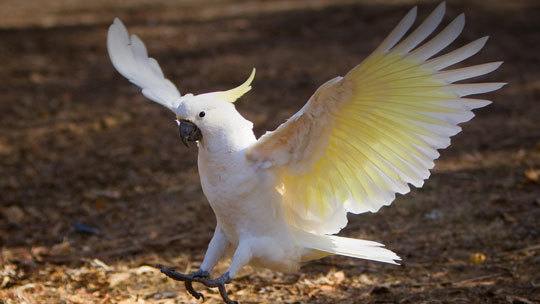
Amazing facts about Cockatoos
Cockatoos are loud! Their screeches and squawks can make your ears ring, and they can be heard a mile away. BUT... I must add that many reports of their volume are exaggerated. It is common to read that they are louder than a 747 jet. Cockatoos (particularly the Molluccan cockatoo, which is one of the loudest) can put out 135 dB of volume. Let's assume that was measured at about 3 meters away, which is what you would hear if you were in the same room. A jet engine puts out about 150 dB at 30 meters. Without getting into the math to prove it, this roughly means that at 170 meters away, the jet engine would be about as loud as the cockatoo at 3 meters away. So the claim that cockatoos are louder than a jet engine are not entirely accurate (calculations with the numbers provided above reveal that the jet engine puts out about 3000 times more sound energy than the cockatoo). But regardless, these birds are insanely LOUD. You would not want to have a pet cockatoo in an apartment building.
Check out this video of a loud Umbrella Cockatoo.
Cockatoos can bite hard! Most parrrots can bite hard because they feed on nuts and fruits that are very difficult to tear into or crack open (not to mention they use their beaks to help them climb). But unlike other parrots, cockatoos' lower mandibles have two prongs. Along with the curved single point of their upper jaw, this gives them what is called a three-way bite. So they can do more damage than other birds their size. Reports of jaw strength of parrots vary widely, but it appears that the large macaws can bite with a force of about 400 psi (pounds per square inch), and the larger cockatoos can bite at about 350 psi. Youch! In fact, wild cockatoos are known to cause considerable damage to houses and anything else made of wood.
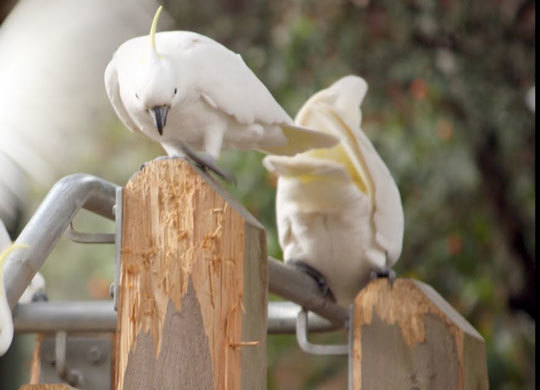
Not all cockatoos are white. Although we typically see several of the white species in pet shops, other species of cockatoos can be a variety of beautiful colors. Below (from left to right) is the Red-Tailed Black Cockatoo, the Black Palm Cockatoo, and the Pink Cockatoo (also called the Major Mitchell's Cockatoo).

Cockatoos live a long time. The smallest of the cockatoos, the cockatiel (a very common pet bird) lives 10 - 14 years. But most of the larger cockatoos live 40 - 50 years. Keep in mind, though, that this is their lifespan in captivity, where they tend to live much longer than in the wild. The White Cockatoo has an average life span of 40 - 60 years. Supposedly, the longest-lived cockatoo ever was Cocky Bennett. Cocky was a sulfur-crested cockatoo that lived at the Sea Breeze Hotel at Tom Uglys Point, Blakehurst (New South Wales, Australia). Cocky was known for his "patter." He died in 1916 at the age of 120 years! See photo below.
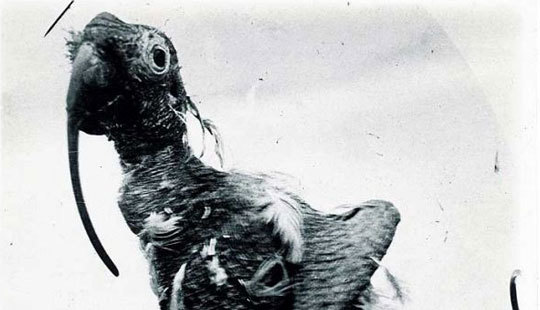
Whether you consider this a good thing or a bad thing, what really boosted the popularity of cockatoos as pets was a 1970s crime show on television. When I was a teenager, I used to watch Baretta, a refreshigly (for its time) gritty cop show about the detective, Tony Baretta (played by Robert Blake). Tony was kind of a loner, but he took comfort in talking to his pet sulfur-crested cockatoo, Fred.

Cockatoos are actually wild animals. I know, this seems obvious, but almost all of the available information on cockatoos has something to do with keeping them as pets. But if you read the information above, there are very good reasons to NOT keep them as pets. They are LOUD. They BITE hard. And they can OUTLIVE their owner. So let's not forget that cockatoos are amazing wild birds that are worth understanding better. I have been fortunate enough to travel to Australia only once, back in 1995 (although Trish and I are planning to go again in 2018!!). I remember the first time I saw cockatoos in the wild. We visited Fitzroy Island, and they were common there, chattering and feeding in the trees. I was so enthralled by them! So, as a reminder that cockatoos are not just popular pets, check out this video on the wild parrots and cockatoos of Australia.
So, the cockatoo deserves a place in the B.A.H.O.F. (Brilliant Animal Hall of Fame).
FUN FACT: The word brilliant originated in about 1680, as the french word, brillant, meaning shining. It has always, and still does, mean sparkling or shining brightly. But it has also evolved (especially in British English) to mean splendid or magnificent, which is a perfect fit for cockatoos. In other words, it is another way to say awesome.
Photo Credits:
Sulfur Crested Cockatoo #1 - San Diego Zoo
Cockatoos chewing wood - Samantha Dunn
Colorful Cockatoos - Pinterest
Cocky Bennett - Archive of Sutherland Shire Libraries, Australia
Baretta and Fred - NBC News
So what the heck is a Cockatoo ?
Cockatoos are parrots. There are about 21 species of cockatoos, making up the family of birds known as Cacatuidae . Perhaps the most recognizable thing about cockatoos is their spectacular crest, a group of feathers on top of their heads that they can raise and lower when circumstances require it. They are also typically less colorful than some of the other parrots. Most cockatoos are white, but some are pink, gray, and a few are black. Cockatoos live in Australia, New Guinea, and many islands of the Malay Archipelago. Below is a sulfur-crested cockatoo.

Amazing facts about Cockatoos
Cockatoos are loud! Their screeches and squawks can make your ears ring, and they can be heard a mile away. BUT... I must add that many reports of their volume are exaggerated. It is common to read that they are louder than a 747 jet. Cockatoos (particularly the Molluccan cockatoo, which is one of the loudest) can put out 135 dB of volume. Let's assume that was measured at about 3 meters away, which is what you would hear if you were in the same room. A jet engine puts out about 150 dB at 30 meters. Without getting into the math to prove it, this roughly means that at 170 meters away, the jet engine would be about as loud as the cockatoo at 3 meters away. So the claim that cockatoos are louder than a jet engine are not entirely accurate (calculations with the numbers provided above reveal that the jet engine puts out about 3000 times more sound energy than the cockatoo). But regardless, these birds are insanely LOUD. You would not want to have a pet cockatoo in an apartment building.
Check out this video of a loud Umbrella Cockatoo.
Cockatoos can bite hard! Most parrrots can bite hard because they feed on nuts and fruits that are very difficult to tear into or crack open (not to mention they use their beaks to help them climb). But unlike other parrots, cockatoos' lower mandibles have two prongs. Along with the curved single point of their upper jaw, this gives them what is called a three-way bite. So they can do more damage than other birds their size. Reports of jaw strength of parrots vary widely, but it appears that the large macaws can bite with a force of about 400 psi (pounds per square inch), and the larger cockatoos can bite at about 350 psi. Youch! In fact, wild cockatoos are known to cause considerable damage to houses and anything else made of wood.

Not all cockatoos are white. Although we typically see several of the white species in pet shops, other species of cockatoos can be a variety of beautiful colors. Below (from left to right) is the Red-Tailed Black Cockatoo, the Black Palm Cockatoo, and the Pink Cockatoo (also called the Major Mitchell's Cockatoo).

Cockatoos live a long time. The smallest of the cockatoos, the cockatiel (a very common pet bird) lives 10 - 14 years. But most of the larger cockatoos live 40 - 50 years. Keep in mind, though, that this is their lifespan in captivity, where they tend to live much longer than in the wild. The White Cockatoo has an average life span of 40 - 60 years. Supposedly, the longest-lived cockatoo ever was Cocky Bennett. Cocky was a sulfur-crested cockatoo that lived at the Sea Breeze Hotel at Tom Uglys Point, Blakehurst (New South Wales, Australia). Cocky was known for his "patter." He died in 1916 at the age of 120 years! See photo below.

Whether you consider this a good thing or a bad thing, what really boosted the popularity of cockatoos as pets was a 1970s crime show on television. When I was a teenager, I used to watch Baretta, a refreshigly (for its time) gritty cop show about the detective, Tony Baretta (played by Robert Blake). Tony was kind of a loner, but he took comfort in talking to his pet sulfur-crested cockatoo, Fred.

Cockatoos are actually wild animals. I know, this seems obvious, but almost all of the available information on cockatoos has something to do with keeping them as pets. But if you read the information above, there are very good reasons to NOT keep them as pets. They are LOUD. They BITE hard. And they can OUTLIVE their owner. So let's not forget that cockatoos are amazing wild birds that are worth understanding better. I have been fortunate enough to travel to Australia only once, back in 1995 (although Trish and I are planning to go again in 2018!!). I remember the first time I saw cockatoos in the wild. We visited Fitzroy Island, and they were common there, chattering and feeding in the trees. I was so enthralled by them! So, as a reminder that cockatoos are not just popular pets, check out this video on the wild parrots and cockatoos of Australia.
So, the cockatoo deserves a place in the B.A.H.O.F. (Brilliant Animal Hall of Fame).
FUN FACT: The word brilliant originated in about 1680, as the french word, brillant, meaning shining. It has always, and still does, mean sparkling or shining brightly. But it has also evolved (especially in British English) to mean splendid or magnificent, which is a perfect fit for cockatoos. In other words, it is another way to say awesome.
Photo Credits:
Sulfur Crested Cockatoo #1 - San Diego Zoo
Cockatoos chewing wood - Samantha Dunn
Colorful Cockatoos - Pinterest
Cocky Bennett - Archive of Sutherland Shire Libraries, Australia
Baretta and Fred - NBC News
Published on December 13, 2017 05:42
November 25, 2017
Awesome Animal - Kaprosuchus
If you haven't noticed from my previous emails, I have been featuring many of the creatures that make appearances in my novel
Profusion
, the third novel in the Diffusion series. Today's Awesome Animal is also in
Profusion
, making a brief but frightening appearance.
So what the heck is a Kaprosuchus ?
Kaprosuchus (pronounced Kap-roe-soo-kuss) is an extinct crocodile that lived in the late Cretaceous period, about 95 to 100 million years ago. You probably know most dinosaurs became extinct soon after a large asteroid impact about 66 million years ago (except for those that evolved into birds). So Kaprosuchus lived alongside some of the dinosaurs (and probably ate them). But it was a crocodile, like our modern crocodiles, and therefore was not a dinosaur.
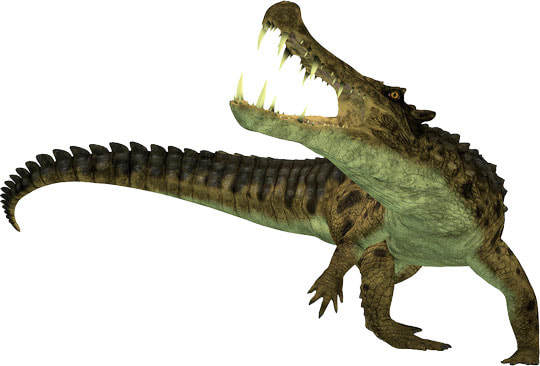 Amazing facts about Kaprosuchus
Amazing facts about Kaprosuchus
One of the most striking features of this crocodile is that it had three pairs of enormous tusk-like teeth. Which is how it got its common name, the BoarCroc. The long teeth resemble those of a wild boar. These teeth are longer than any other crocodilre teeth known. They are so long that this creature couldn't possibly have closed its mouth if it didn't have grooves in the jaws for the teeth to slide into. See the skull below:
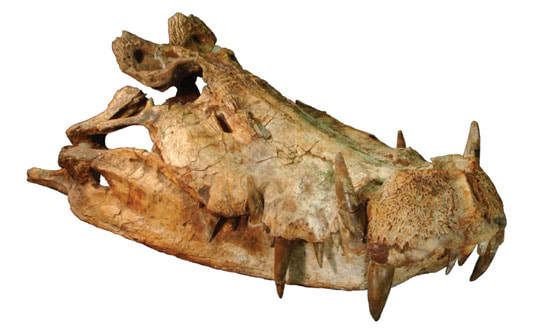 And speaking of the skull in the photo above. The ony reason we are aware this species ever existed is that this
one single fossil skull
has been found. It was discovered in 2009 in Niger (Africa). Everything we know about Kaprosuchus is based upon this one skull. But this skull is unique among crocodile skulls, and it can tell us quite a bit.
And speaking of the skull in the photo above. The ony reason we are aware this species ever existed is that this
one single fossil skull
has been found. It was discovered in 2009 in Niger (Africa). Everything we know about Kaprosuchus is based upon this one skull. But this skull is unique among crocodile skulls, and it can tell us quite a bit.
Even though this Kaprosuchus skull was found only recently, the unusual features of this species have captured the imaginations of people worldwide, and the Kaprosuchus is featured in many illustrations, video games, and movies. You can even buy a toy Kaprosuchus, like the one below:
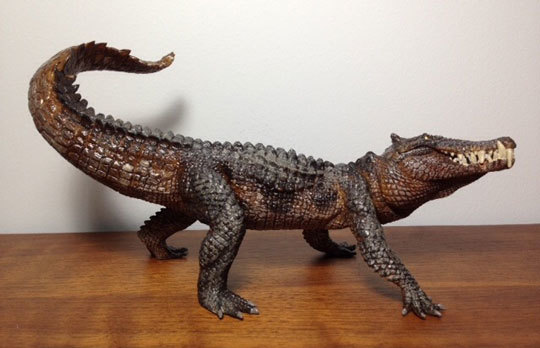
Based on the structure of the creature's skull, it had eyes that were arranged to look forward. Most crocodiles (including all living ones today) have eyes high on the head so that they are above water when most of the rest of the body is hiding beneath the surface. Also, most crocodiles' eyes look to either side rather than ahead. Because of this forward-looking arrangement, it is assumed the Kaprosuchus had depth perception and therefore could run after prey on land. That's why most illustrations of Kaprosuchus include unusually long legs, especially the back legs. This is based on the size of the legs of other fossil crocodiles that we believe hunted on land.
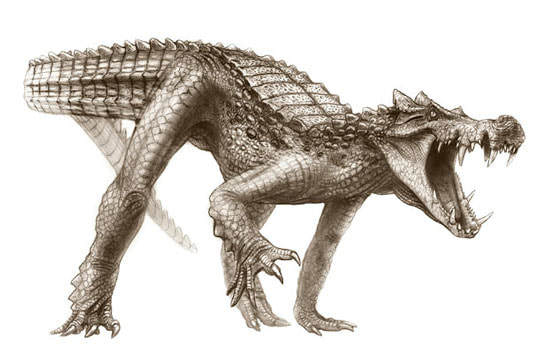 Even the short-legged crocodiles living today are much faster and more agile than many people realize. They can run and even jump (see the image below of a Nile crocodile being fed). This is how the Nile crocodile can catch and kill creatures like the wildebeest. So if today's short-legged, mostly-aquatic crocodiles are that fast, imagine the speed of the longer-legged terrestrial species of the past!
Even the short-legged crocodiles living today are much faster and more agile than many people realize. They can run and even jump (see the image below of a Nile crocodile being fed). This is how the Nile crocodile can catch and kill creatures like the wildebeest. So if today's short-legged, mostly-aquatic crocodiles are that fast, imagine the speed of the longer-legged terrestrial species of the past! 
Check out this video animation of the inferred behavior of some of the recently-discovered crocodile species (the Kaprosuchus segment starts at about two minutes).
So, I believe the Kaprosuchus deserves a place in the F.A.H.O.F. (Fantasmagorical Animal Hall of Fame).
FUN FACT: Fantasmagorical is no doubt derived from phantasmagoric, which means having a macabre or deceptive appearance. But this new version is more a combination of fantastic, amazing, and magical. And therefore I think the word itself is fantasmagorical! Regardless, it is another way to say awesome.
So what the heck is a Kaprosuchus ?
Kaprosuchus (pronounced Kap-roe-soo-kuss) is an extinct crocodile that lived in the late Cretaceous period, about 95 to 100 million years ago. You probably know most dinosaurs became extinct soon after a large asteroid impact about 66 million years ago (except for those that evolved into birds). So Kaprosuchus lived alongside some of the dinosaurs (and probably ate them). But it was a crocodile, like our modern crocodiles, and therefore was not a dinosaur.
 Amazing facts about Kaprosuchus
Amazing facts about Kaprosuchus
One of the most striking features of this crocodile is that it had three pairs of enormous tusk-like teeth. Which is how it got its common name, the BoarCroc. The long teeth resemble those of a wild boar. These teeth are longer than any other crocodilre teeth known. They are so long that this creature couldn't possibly have closed its mouth if it didn't have grooves in the jaws for the teeth to slide into. See the skull below:
 And speaking of the skull in the photo above. The ony reason we are aware this species ever existed is that this
one single fossil skull
has been found. It was discovered in 2009 in Niger (Africa). Everything we know about Kaprosuchus is based upon this one skull. But this skull is unique among crocodile skulls, and it can tell us quite a bit.
And speaking of the skull in the photo above. The ony reason we are aware this species ever existed is that this
one single fossil skull
has been found. It was discovered in 2009 in Niger (Africa). Everything we know about Kaprosuchus is based upon this one skull. But this skull is unique among crocodile skulls, and it can tell us quite a bit.Even though this Kaprosuchus skull was found only recently, the unusual features of this species have captured the imaginations of people worldwide, and the Kaprosuchus is featured in many illustrations, video games, and movies. You can even buy a toy Kaprosuchus, like the one below:

Based on the structure of the creature's skull, it had eyes that were arranged to look forward. Most crocodiles (including all living ones today) have eyes high on the head so that they are above water when most of the rest of the body is hiding beneath the surface. Also, most crocodiles' eyes look to either side rather than ahead. Because of this forward-looking arrangement, it is assumed the Kaprosuchus had depth perception and therefore could run after prey on land. That's why most illustrations of Kaprosuchus include unusually long legs, especially the back legs. This is based on the size of the legs of other fossil crocodiles that we believe hunted on land.
 Even the short-legged crocodiles living today are much faster and more agile than many people realize. They can run and even jump (see the image below of a Nile crocodile being fed). This is how the Nile crocodile can catch and kill creatures like the wildebeest. So if today's short-legged, mostly-aquatic crocodiles are that fast, imagine the speed of the longer-legged terrestrial species of the past!
Even the short-legged crocodiles living today are much faster and more agile than many people realize. They can run and even jump (see the image below of a Nile crocodile being fed). This is how the Nile crocodile can catch and kill creatures like the wildebeest. So if today's short-legged, mostly-aquatic crocodiles are that fast, imagine the speed of the longer-legged terrestrial species of the past! 
Check out this video animation of the inferred behavior of some of the recently-discovered crocodile species (the Kaprosuchus segment starts at about two minutes).
So, I believe the Kaprosuchus deserves a place in the F.A.H.O.F. (Fantasmagorical Animal Hall of Fame).
FUN FACT: Fantasmagorical is no doubt derived from phantasmagoric, which means having a macabre or deceptive appearance. But this new version is more a combination of fantastic, amazing, and magical. And therefore I think the word itself is fantasmagorical! Regardless, it is another way to say awesome.
Published on November 25, 2017 16:31



